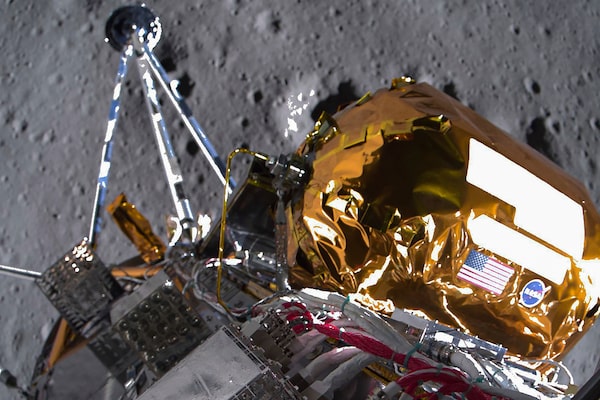
The Odysseus lunar lander over the south pole region of the Moon in this image provided by Intuitive Machines on Feb. 27.The Associated Press
Odysseus, the first U.S. spacecraft to land on the moon in half a century, was expected to go dark on Wednesday, six days after an off-kilter touchdown that hindered its communications and solar-charging capability, NASA and the company that flew the vehicle said.
Despite persistent difficulties in communicating with the lander and keeping it charged, NASA said it managed to extract data from all of its science payloads delivered to the lunar surface by the lander, flown by Texas-based Intuitive Machines.
“We have conducted a very successful mission at this point,” Intuitive Machines CEO Stephen Altemus said at a joint news briefing with NASA officials. He said the flow of information retrieved from the spacecraft increased substantially after “sporadic” communications during the first few days.
Sue Lederer, a NASA project scientist, described the flow of data as going from “a cocktail-size straw to a boba-tea-size straw of data.”
Engineers plan to put Odysseus “to sleep” on Wednesday evening as the lander ends its sixth day on the lunar surface, once solar power regeneration is no longer sufficient to keep it running and sending telemetry back to Earth, at around 8 p.m. EST (0100 GMT), Altemus said.
But he said flight controllers would seek to restart Odysseus in around three weeks, after the sun rises again over the vehicle’s landing site in the moon’s south pole region.
NASA and Intuitive Machines had said before the mission’s launch that the payloads were expected to operate on the lunar surface for roughly seven days before night fell.
The Nova-C-class lander, shaped like a hexagonal cylinder and standing 13 feet (4 m) tall, was launched on Feb. 15 from NASA’s Kennedy Space Center in Florida on a Falcon 9 rocket supplied by Elon Musk’s SpaceX. It arrived in lunar orbit six days later.
The six-legged vehicle reached the lunar surface last Thursday after an 11th-hour navigational glitch and descent that ended with Odysseus catching one of its feet on the ground and landing in a sharply tilted position, immediately impeding its operations.
Intuitive Machines have said human error was to blame for the navigational issue. Flight readiness teams had neglected to manually unlock a safety switch before launch, preventing subsequent activation of the vehicle’s laser-guided range finders and forcing flight engineers to hurriedly improvise an alternative during lunar orbit.
Whether or not failure of the range finders and last-minute substitution of a workaround ultimately caused Odysseus to land askew remained an open question, according to Intuitive officials.
A newly released image on Wednesday showed the spacecraft as it was touching down on the surface, with its landing gear visibly damaged.
Altemus said the spacecraft was moving faster than expected during final approach and skidded to a stop as it landed. Altemus said it ended up tilted at a 30-degree angle.
The company said that two of the spacecraft’s communication antennae were knocked out of commission, pointed the wrong way, and that its solar panels were likewise facing the wrong direction, limiting the vehicle’s ability to recharge its batteries.
As a consequence, Intuitive said earlier this week that it expected to lose contact with Odysseus on Tuesday morning, prematurely terminating the mission.
But the projected deadline for the lander’s finale came and went as the company reported the spacecraft still functioning with additional battery life.
Despite its less-than-ideal touchdown, Odysseus became the first U.S. spacecraft to land on the moon since NASA’s last crewed Apollo mission to the lunar surface in 1972.
It was also the first lunar landing ever by a commercially manufactured and operated space vehicle, and the first under NASA’s Artemis program, which aims to return astronauts to Earth’s natural satellite this decade.
To date, space agencies of just four other countries have ever achieved a “soft” moon landing – the former Soviet Union, China, India and, just last month, Japan, whose lander likewise tipped over on its side. The United States is the only country ever to have sent humans to the lunar surface.